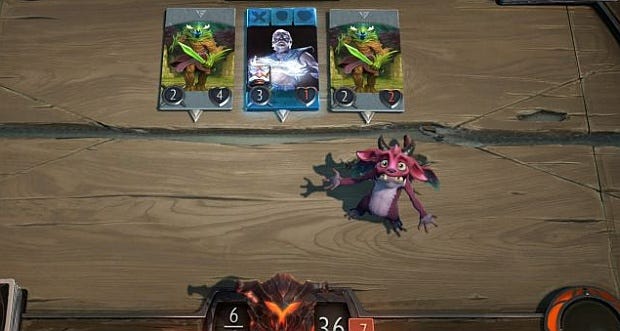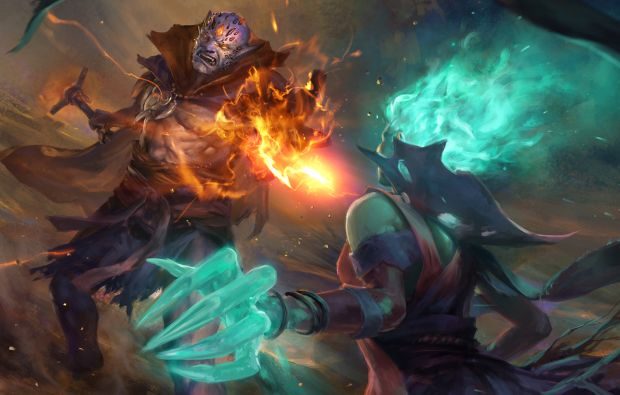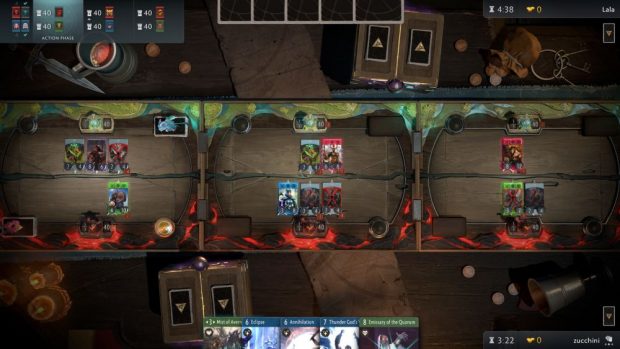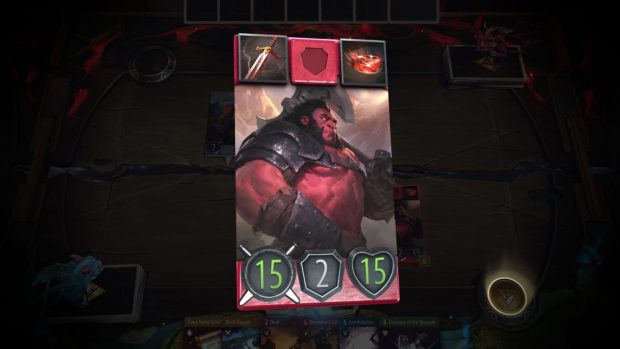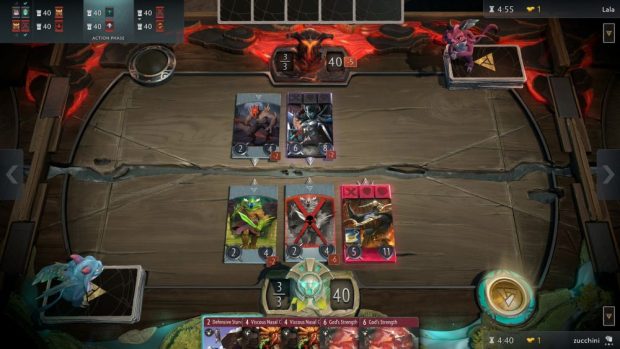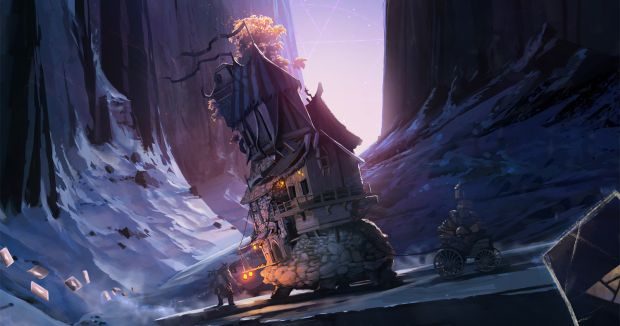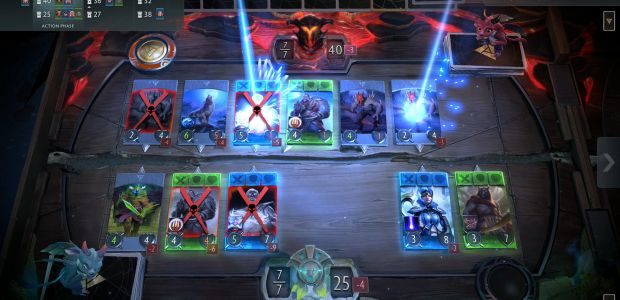Artifact feels like Valve's solution to post-Hearthstone card games
From deckbuilding to ranked play
Collectible card games have been around for decades, but they've really been running hot ever since Blizzard unleashed Hearthstone four years ago. Since then, we've seen Shadowverse, Gwent, The Elder Scrolls: Legends, Duelyst, Faeria - there are a lot of these things, if you haven't heard. They all put their own spin on rectangles with numbers on 'em, but they also universally take cues from Hearthstone and, just as often, each other, and as a result they regularly run into similar problems, the biggest two being how to balance a competitive system and how to price card packs fairly.
Artifact, Valve's upcoming Dota-inspired card game, is definitely using some pages from the same books, but it's also doing enough things differently that it has the potential to solve a lot of those problems.
For starters, it's not free. We don't know how much it will cost just yet, but Artifact will have an upfront cost when it releases later this year. Which is going to put some people off, but quite frankly, I expect Artifact to put some people off. I recently had the chance to play it myself, and while I liked its mix of MOBA rules and card game systems, it's a niche and complex game that won't appeal to everyone. I get the feeling Valve is going for a dedicated audience rather than the biggest one possible, so opting for a premium price over a freemium model makes sense.
"We've experimented a lot with different types of free-to-play games," Artifact programmer Jeep Barnett said, "and it really depends on what we're trying to do with that game. With Dota it made sense because the original was free and players expected it. In this case, we find that having an upfront cost is going to better for the game long-term."
Programmer Bruno Carlucci added that "having an upfront cost gives you a set of things to start with, which then gives you the tools to go and find the things you want," referring to Artifact's Steam Market integration. You can buy and sell Artifact cards via a built-in storefront, which is another big departure from modern collectible card games where you build up your own static collection. An open card market could provide a preferable workaround to the RNG of opening card packs, ideally making filling the gaps in your deck or collection easier and cheaper.
"People will be able to build decks for a couple bucks, very easily," Carlucci said. "And you also retain the value of your deck, so if you spend some money and then you're like 'I'm done with this deck,' you don't lose that investment. You can sell those cards and buy another deck instead."
My hope is that being able to trade cards in Artifact, coupled with the cards you start with, will help alleviate the grind that free-to-play card games inevitably come back to. Hearthstone is a free game, sure, but I've spent over $100 on it because buying card packs felt necessary to stay competitive. Shadowverse showers you in free packs whenever a new expansion is released, but its crafting system is so stingy that I still feel compelled to spend money. If Artifact can strike a balance where I can quickly, comfortably build a variety of decks using only the cards I get for buying in and whatever I earn just by playing, I'll gladly pay up front. At least then I know exactly what my money will get me and how much I'll have to spend.
The pace and price of Artifact's card economy remains to be seen, but the infrastructure Valve has laid out is promising. The studio also has big plans for improving on the ranked ladder system seen in many card games.
"We don't want to do a ladder," Barnett said. "We're experimenting with different systems that are more tournament-oriented rather than ladder-oriented. The idea is that if you want a competitive experience, you get a more self-enclosed experience. A good inspiration we have is that Dota has these Battle Cups. Every Saturday you get to play in a single elimination tournament, and if you win you're done. We feel that those experiences are better for people who actually want to try something out, it allows them to explore something. They know how many matches they have to play and win, which is much better than just playing this infinite grind that doesn't really get you anywhere."
"We're experimenting with a lot of things right now, we'll probably have a better idea later," Carlucci said. "One of the things about ladders that we've noticed is that they tend to optimize for, rather than the most fun deck or the best deck, the deck that can win 51 percent of the time as fast as possible. It not only affects the experience of other users who feel like they're playing against a deck over and over, it also makes people play with decks they might not want to play with just because it's the most optimal thing."
Likewise, Valve wants to diversify Artifact's competitive experience by offering alternative game modes. "We want to do limited (a mode where you draft a deck from random cards)," Barnett said. "We're still working on the design of it so it's hard to promise something very specific. We've been testing those internally and they're really, really fun."
"That's one of the things Richard Garfield and Skaff Elias are really excited about, because of course they have this sea of experience from working on Magic: The Gathering," Carlucci said. "But keep in mind this is a digital card game, so we can do a lot of things we couldn't do within the limitations of a physical card game."
"Cards will rotate. That's a good thing in general, [because] it avoids things like power creep," Barnett said. Power creep is when new cards replace old ones because they're just objectively better versions, and if left unchecked, it makes new expansions less and less exciting. "It also makes it more accessible for people that want to jump in a couple years down the line. They don't have a backlog of cards."
"This is years down the line, but maybe doing classic formats or formats with certain blocks, maybe those are randomly chosen, maybe we pick specific things that we think are interesting," Carlucci added.
"One of the most important things, and we learned this from our other games as well, is that we let the community figure those things out," Barnett said. "Rather than deciding 'this is how you're gonna play,' we'd rather give the community the tools for them to be able to make those formats. So tomorrow, you wanna run a tournament and you say 'I only want cards that start with the letter 'C.' You can build that and you have the tools to make sure that the people playing that tournament follow those rules. The limit is not what we decide, but rather the imagination of the community."
Barnett's idea of creating a small tournament where you can only play 'C' cards would be a perfect fit for playing Magic with friends on a kitchen table. In a similar vein, Artifact's three-lane board helps recreate the tiebreakers and rematches that you get in physical card games.
"When you match with someone in the real world, it's like 'I win, wanna play another game?' And then we do," Barnett said. "It gives you a sense of who's better overall, not just who's better because of what happened to happen in that one game. Online, it's really hard to get a rematch. You just say 'I played you and lost, so I'll play somebody else now.' Having the three lanes is almost like a best-two-out-of-three battle. We get a sense of winning or losing on different lanes within the space of a single game without having to worry about rematching."
I experienced this best-of-three effect in my second game of Artifact, where I wound up playing totally separate strategies in all three lanes. I saw more of my deck and my opponent's deck as a result, and we squared off in different and interesting ways, which made my victory more satisfying and feel more definitive. And Artifact not only creates holistic games, it does it quickly: the turn timer is about 45 seconds, and games usually last around 12 minutes according to Valve's internal testing.
Playing in three lanes at once also makes matchups less repetitive, which has become an especially thorny problem in Hearthstone over the past few months thanks to Warlock and Rogue, whose dominance has totally polarized the Standard meta. Artifact is still a card game so all decks are going to perform better against some decks than others, but even in your worst matchup, you get multiple chances to turn it around. And when you do hit bad matchups, you'll have more ways to respond thanks to your item deck, a bundle of neutral cards that's paired with your main deck. As Carlucci puts it, your item deck is basically your side deck, a collection of hand-picked tools to advance your strategy or defend against strategies you're weak against. Card games are at their best when they give players effective ways to respond to popular strategies, and Artifact's item decks do just that, which gives it a unique and powerful advantage in building and balancing an enjoyable meta.
If I had to narrow it down to one thing, I'd say Artifact's biggest strength is that it takes lessons from trading card games like Magic as much as it does collectible card games like Hearthstone. I reckon Elias and Garfield's involvement has something to do with that. In fact, as Barnett told me, Artifact originally got started because Elias, Garfield and some folks from Valve "wanted to work on a cool electronic card game." Artifact is still several months away, and I still have plenty of questions about how its ambitious ideas will play out, but it's encouraging to see Valve not only stand on the shoulders of giants but also ask questions themselves. And after four years of fun but frequently frustrating card games, I think they're asking the right ones.
Artifact is due for release later this year.
